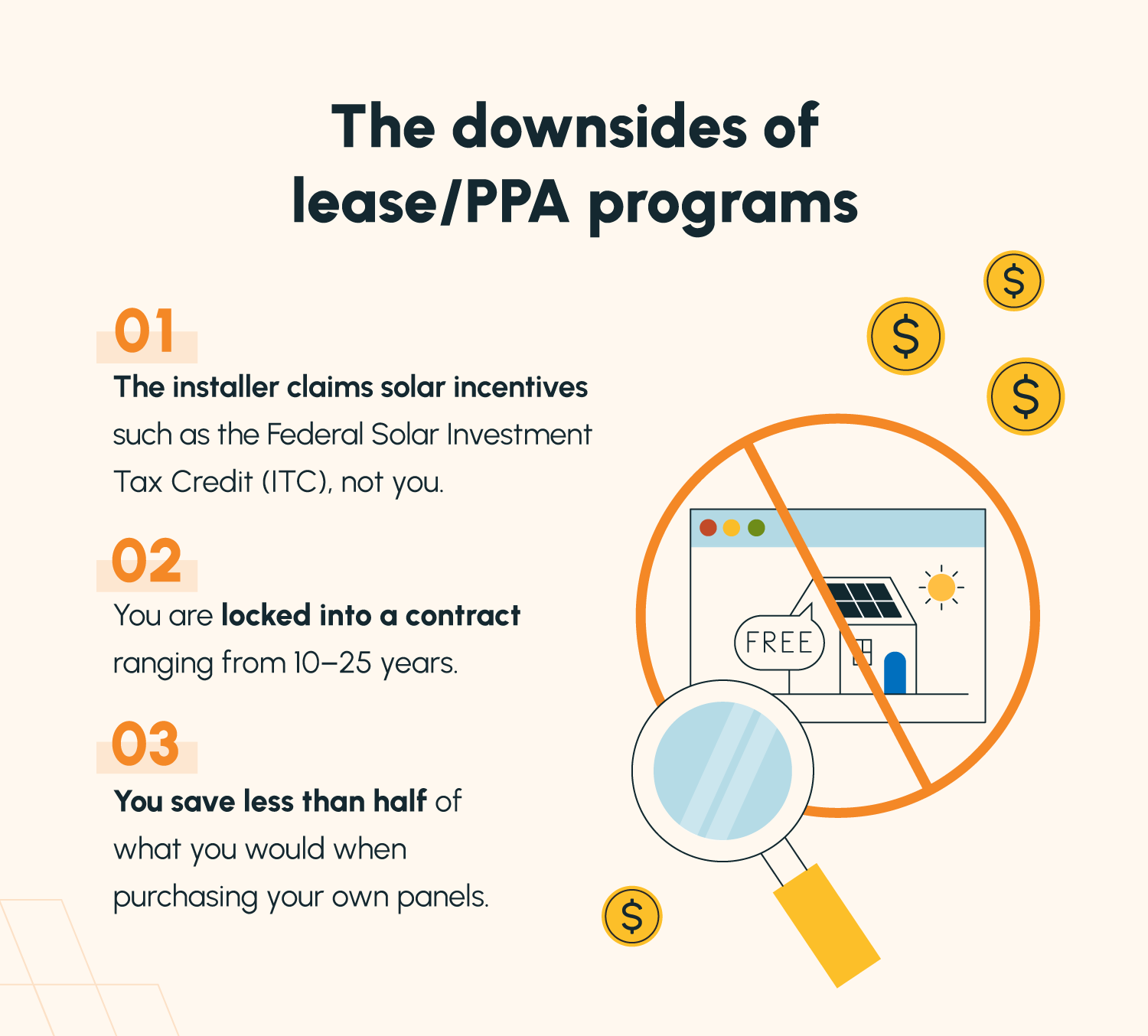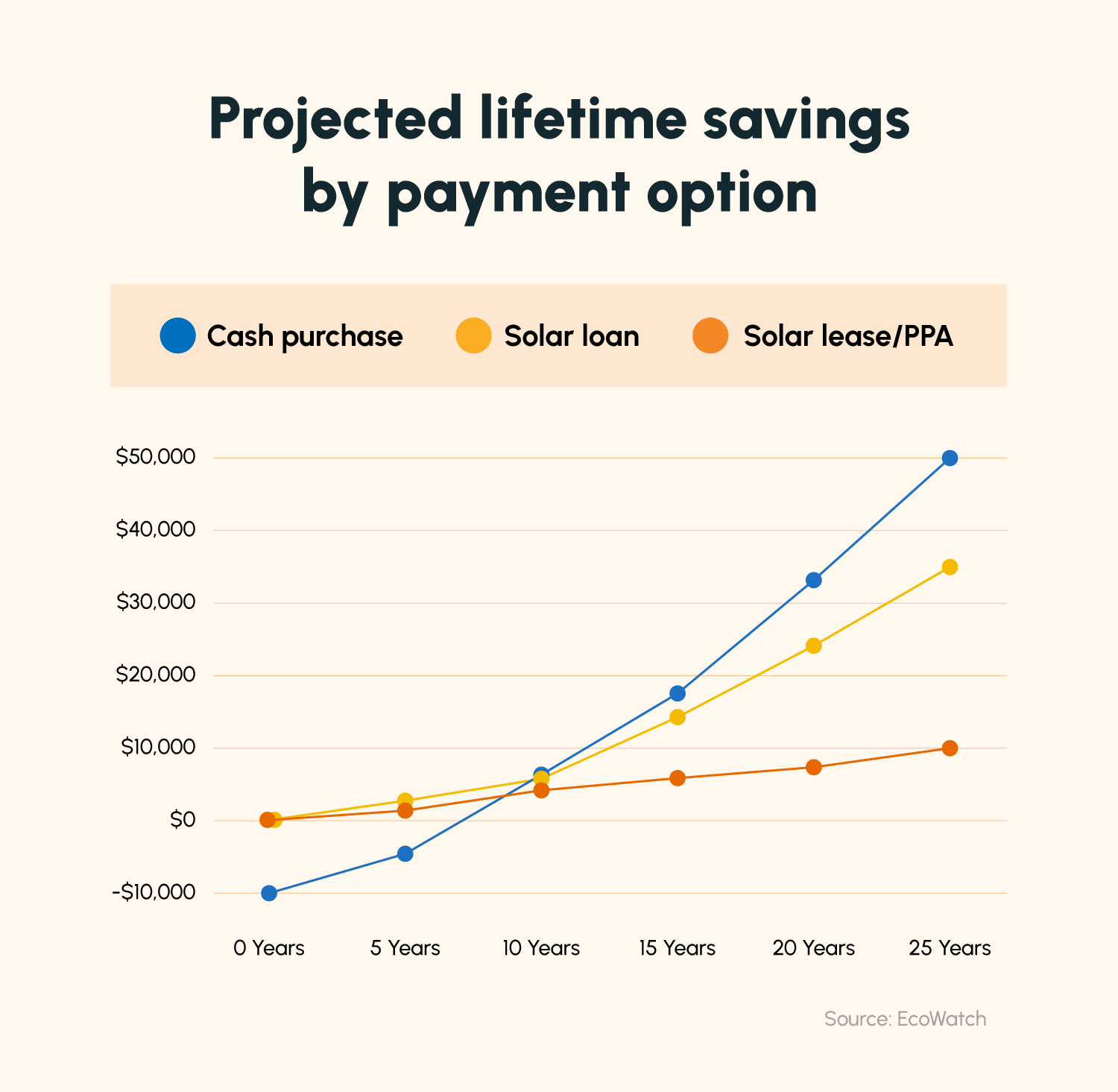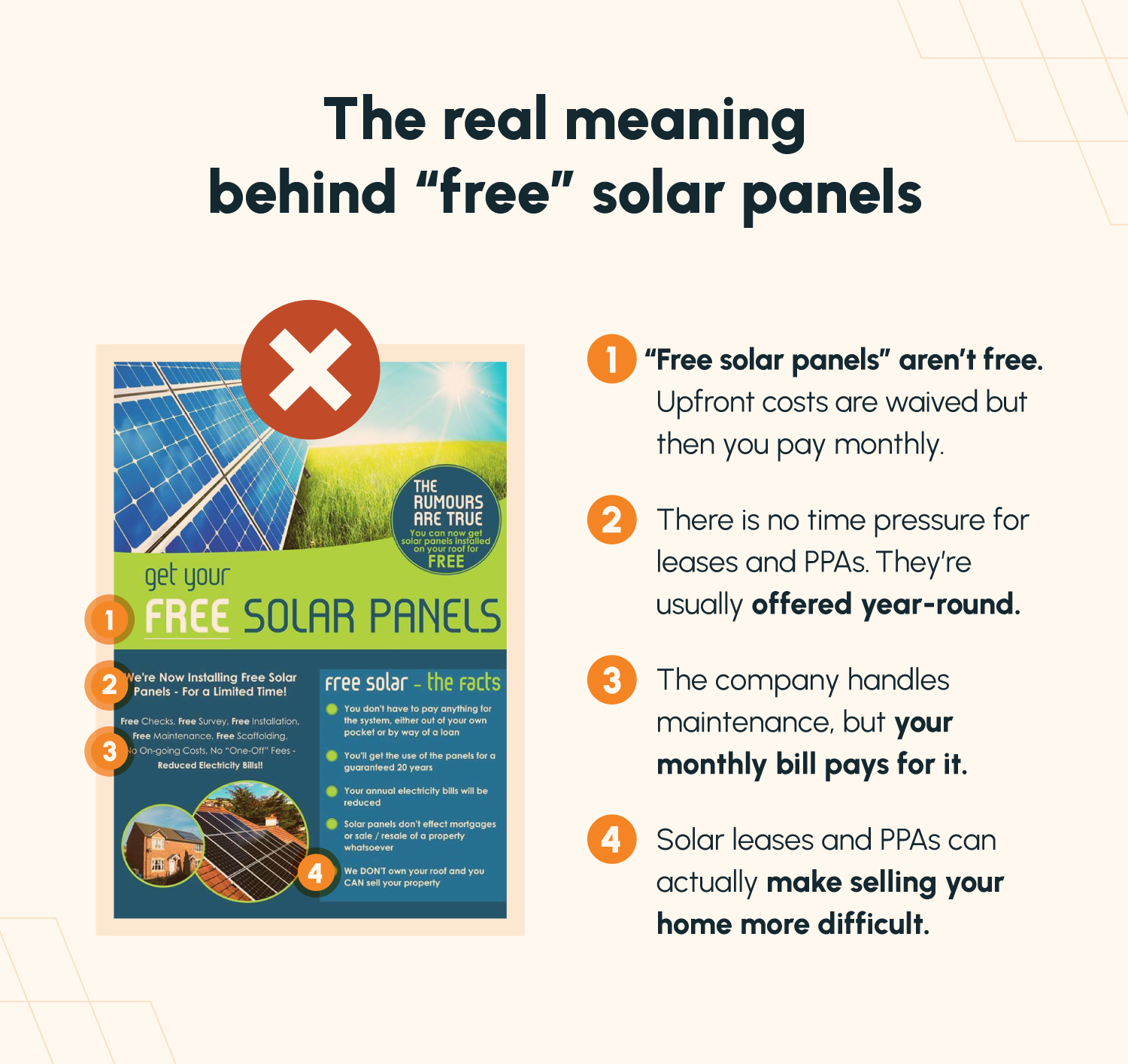If you’ve been exploring solar panel financing options, you’ve likely heard some solar providers promise “free solar panels.” If your brain immediately reacts to this phrase with “That sounds too good to be true,” your intuition is spot-on.
“Free solar panels” aren't actually free, but rather, this phrase is usually used in the context of solar leases and power purchase agreements (PPAs).
We'll get into the details shortly, but first, here’s the short answer: While you technically pay nothing upfront with solar leases and PPAs, the phrase “free solar panels” is highly misleading since these agreements require monthly payments and do not give you ownership of the panels on your roof.
At Solartap, we put extensive research into lowering the cost of solar for those who want to offset their carbon footprint and save money on electricity. You can count on us to share affordable solar options without making false promises like “free solar panels.”
In this guide, we unpack the real meaning of the “free solar panels” sales pitch and propose ways to actually lower the upfront cost of solar panels without entering a leasing or PPA agreement.
The Real Meaning of “Free Solar Panels”: Solar Leases & Solar PPAs
As mentioned earlier, “free solar panels” is a common part of solar lease or PPA sales pitches.
Solar leasing works much like leasing a vehicle — you pay a fixed monthly fee to “rent” the solar panels on your roof and use the energy they generate. With a solar lease, you don’t own the panels and therefore don’t build home equity; they’re owned by the leasing company.
A solar PPA functions similarly, but instead of paying a fixed monthly fee, the homeowner pays the PPA company a certain rate for the amount of electricity they use from month to month. For this reason, their monthly bill varies depending on electricity use.
The “free solar panels” claim refers to the fact that solar leases and PPAs require no down payment or installation fees — the company covers these costs.
However, this phrase disregards the fact that the homeowner still pays monthly to use the panels, rather than owning the panels and using the energy they produce. For this reason, solar panels are not, in fact, free.
The Hidden Costs of “No-Cost Solar”

So why do companies promise “no-cost solar”? You might be thinking, “Was I almost roped into a free solar panel scam?”
These are valid questions after learning that the phrase “free solar panels” is a pretty misleading marketing tactic. While legitimate solar leasing and PPA programs are not scams, there are reasons why companies try to convince prospective solar customers to lease rather than purchase their own panels. We unpack these below.
Why Companies Market Solar Leases and Solar PPAs
Owning solar panels comes with some attractive government incentives, with the most significant being the Federal Solar Investment Tax Credit (ITC). This provides a 30% tax credit for solar systems installed between 2022 and 2032.
When a homeowner buys their own panels, they claim the ITC in addition to any local incentives for going solar. When companies enter into leasing or PPA agreements with a homeowner, it’s the company that claims these benefits — not the homeowner.
Further, lease and PPA contracts are long — ranging from 10 to 25 years and usually falling on the longer end of the spectrum. This guarantees the leasing or PPA company a long-term steady source of income.
The Payoff of Leases and PPAs vs. Other Financing Options

Another hidden cost of solar leases and PPAs is the minimal long-term payoff compared to other solar financing options. Below, we cover the difference between them.
Cash Purchase
A cash purchase refers to paying for your entire solar system upfront. While it requires the highest initial cost, it also provides the highest return on investment (ROI).
With a cash purchase:
- You begin generating your own energy immediately.
- You stop paying your utility company for energy immediately.
- You reap the tax benefits and other investments of going solar.
Solar Loan
A solar loan offers the next highest ROI. Most solar loans, much like solar leases and PPAs, require $0 down. This allows you to install your system without worrying about the high upfront cost of a cash purchase, while still reaping many of the same benefits.
Of course, this comes at the cost of interest, which means you’ll be paying more for your system over time than you would be with an upfront cash purchase. That said, you’ll still be saving significantly more with a loan than with a lease or PPA.
With a solar loan:
- You pay $0 upfront.
- You generate all of your own energy immediately.
- You stop paying your utility company and start paying your solar company instead.
- When you’re done paying it off, you own the solar system.
Solar Lease & PPA
Solar leases and PPAs offer the lowest ROI of all solar financing options. While you don’t pay any upfront costs with a solar lease or PPA, over half of your potential savings go to the solar installer in the form of monthly payments.
With a solar lease or PPA:
- You trade your utility bill for a slightly less expensive bill to your solar company.
- You do not own the panels on your roof.
- You do not build home equity by installing the panels.
- You will be paying monthly to use the panels for as long as they’re on your roof.
Unpacking a “Free Solar” Ad
Next, let’s take a look at a real-life example of a “free solar panels” ad and break down what makes this concept misleading.

- “Free solar panels” / “You don’t have to pay anything for the system.” As we’ve already covered, the language “free solar panels” is misleading. Only upfront costs such as installation and materials are waived, but in reality the customer is not buying the panels and will be paying monthly to use them.
- “For a limited time.” This statement creates time pressure where there is none. Zero-dollar-down solar leases and PPAs are offered by a multitude of companies. This language suggests that there is some type of short-term solar panel giveaway, which is unrealistic and untrue.
- “Free maintenance.” While it’s true that the leasing or PPA company covers maintenance costs, the homeowner pays a monthly fee. This fee covers maintenance (and much more).
- “You CAN sell your property.” Solar leases and PPAs are notorious for making it more difficult to sell your home while under contract. If the buyer doesn’t want to enter into an agreement and would rather own their solar panels, this can make it more challenging to sell the home.
How to Lower the Upfront Cost of Solar Without a Lease or PPA

It’s understandable why the concept of “free solar panels” is so alluring — solar panels offer so many benefits, and the thought of reaping those benefits at no cost is enticing!
Thankfully, there are ways to lower the upfront cost of installing a solar system that don’t involve entering into a long lease or PPA agreement and losing out on savings.
Research Incentives
There are several solar incentives that can reduce the cost of solar. Whoever owns the panels will claim these benefits, so you must purchase your own panels rather than pursue a lease or PPA in order to receive them.
Some regions offer more incentives than others, so be sure to research what’s available in your area.
- The ITC: As previously mentioned, the ITC provides a significant tax credit to all U.S. homeowners who install solar. You can get reimbursed for up to 30% of the total cost of your solar system from your taxes. For example, if your system costs $10,000, you’d receive $3,000 back through the ITC.
- Solar Renewable Energy Credits (SRECs): These incentives are offered by certain states that have high standards of renewable energy production. Homeowners with solar systems can claim an SREC for every megawatt hour (1,000 kWh) of electricity that their system produces.
- Performance-based incentives: Other performance-based incentives will pay the homeowner to produce a certain amount of solar energy. Essentially, your utility company would pay you for producing a quantity of solar energy, whether you choose to use it or send it back to the grid.
- State and local incentives: Many states offer rebates and/or tax credits to homeowners who invest in solar systems. These can be claimed before also claiming the ITC, allowing you to reap the rewards of both incentives.
Make Installation a DIY Project
Much of the cost of solar comes from installation. If you get a quote from a full-service solar company that provides the materials and handles installation, there’s a good chance they’re significantly marking up installation and material costs.
If you enjoy DIY projects, you can save a significant amount of money by cutting out the installer and making installation its own DIY project.
If you aren’t totally confident about completing such an extensive undertaking, you can always recruit the help of a local contractor for a much lower cost than a turnkey installation.
Take Out a Loan
If the idea of no upfront costs is particularly appealing to you, most solar loans require $0 down, all while offering significantly greater savings than leases and PPAs.
Solar loans tend to have reasonable interest rates, meaning you won’t lose out on most of the financial benefits of solar by taking out a loan. Some solar installers even offer programs to help prospective customers secure a loan.
“Free Solar Panels” FAQ
After learning that the concept of “free solar panels” isn’t all it’s made out to be, you may have some lingering questions about this phrase. We address some common questions below.
What’s the Catch With Free Solar Panels?
“No-cost solar” programs do not actually provide homeowners with solar at no cost.
These programs refer to solar lease and PPA agreements, through which the homeowner doesn’t actually own the solar panels on their roof. Rather, the leasing or PPA company owns the panels and the homeowner pays a monthly fee to use them.
How Do You Get Free Solar Panels From the Government?
The government does not provide homeowners with free solar panels. However, the federal government does offer solar customers the Federal Solar Investment Tax Credit (ITC), which reduces the cost of solar significantly.
There are also local programs such as Solar Renewable Energy Credits (SRECs) that provide monetary incentives for going solar and/or generating a certain quantity of solar energy.
How Does the No-Cost Solar Program Work?
Many solar companies claim to offer a “no-cost solar program” or a “free solar panel program.” These programs actually refer to solar lease and PPA options.
With leases and PPAs, the homeowner is not charged any upfront costs for solar panel installation, but they do not own the solar panels and pay the installer a monthly fee to use them.
In these programs, the solar installer reaps the solar incentives that would otherwise go to the homeowner. The long-term payoff of these programs is also far less than owning panels.
Of course, one of the best ways to bring the cost of your solar panels down is to find a provider that keeps costs low. At Solartap, we’ve cut out unnecessary steps in the solar customer’s journey to bring prices lower without sacrificing quality.
To see how much you can save with us, get a quote using our solar calculator today.




